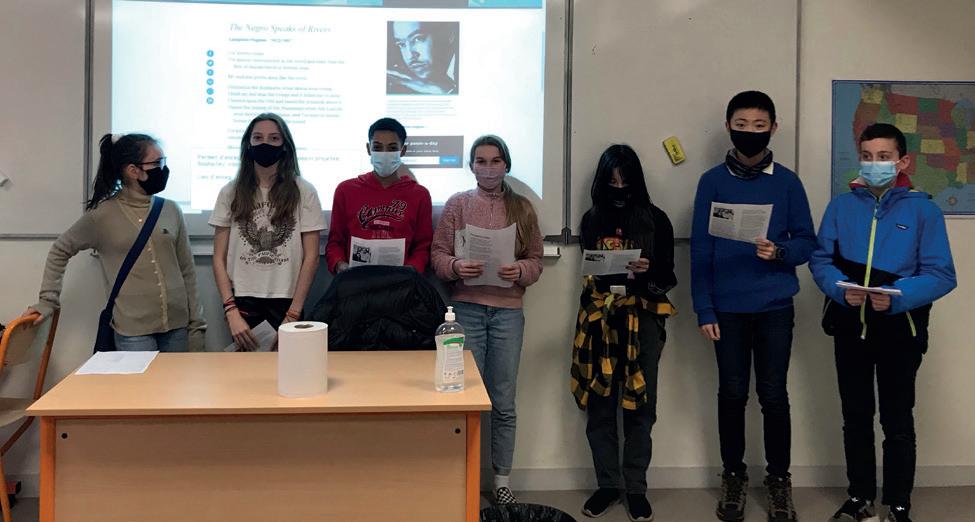
4 minute read
Middle School
from A Year Like No Other - Compass 2021
by American Section Lycée International de St. Germain en Laye
Reconstruction in 2021
Of all the internet memes that have circulated since the beginning of 2021, one has stood out in particular. It was a cartoon of Doc admonishing Marty McFly in front of the DeLorean to “Never set it to the year 2020.” For those of you who aren’t familiar with the film “Back to the Future,” the DeLorean is a time machine. Though many of us would not feel the burning desire to revisit 2020, it is impossible to ignore the growth that came from such an eventful, yet beneficial year.
Advertisement
The year that was hailed to be the best yet, where we would all have “2020 vision,” turned out to be a year full of loss on many levels. The loss of jobs, loss of businesses, loss of trust, loss of certain freedoms, and above all, the loss of too many lives, are only a few that plagued last year. Time and time again humans were forced to fight fires, and I’m not just referring to the wild ones. However, despite all of the devastation and desperation, it is important to recognize the value in what was gained.
As 2020 marched (or rambled) on, the world saw statues topple, institutions being uprooted and movements, such as Black Lives Matter, gaining more momentum in the fight for “Freedom, Liberation, and Justice” (blacklivesmatter.org). These events, along with many others, forced many a school administrator and educator to rethink their curriculum and the way certain teachers are teaching. Though the American Section had already made many steps toward improvements in diversity and inclusion, the Middle School History Department needed a clearer course of action.
To ensure that a department and its curriculum are diverse and inclusive is on-going and ever-evolving work. Especially following the litany of racist, unjust events in the spring of 2020, one of the department’s objectives for the

next school year was to highlight the contributions of Black, indigenous, and people of color through more conscious and purposeful celebrations and lessons throughout the year. This was the beginning of a transformation with the objective of these elements becoming fully integrated at each level of middle school curriculum, all year long. Maya Angelou couldn’t have said it better when addressing the very fact of having such intentional celebrations, “Won’t it be
wonderful when Black history and Native American history and Jewish history and all of US history is taught from one book. Just US history.”
Unbeknownst to many, November is Native American Heritage Month. This is befitting as the celebration of the harvest, and giving thanks to the earth is not a new concept. The day after Thanksgiving is Native American Heritage Day and was celebrated in ENL and ENH classes through geography, the exploration of Wampanoag folk tales, the analysis of speeches, and discussion surrounding the true meaning of Thanksgiving. Future Novembers will see the addition of other events and curricular supplements in hopes, again, of incorporating these all throughout the year.
In January, the Middle School ENH department, in collaboration with Student Council, HRT, Charlotte Jarquin, and Amy Crist, prepared numerous displays and events to celebrate Martin Luther King, Jr., what he represented, and Black History Month. Profiles and quotes of influential POC were posted, speeches were watched, research was done, poems were recited, class discussions were held around themes of tolerance, non-violence, and art, and students were prompted to sit with someone new in the cafeteria and classroom. Though these are baby steps, we hope they take us all, no matter the color of our skin, on a bigger journey. The biggest weapon against racism and discrimination lies in the education of our current and future generations. It has become more important than ever to support the empowerment of people of color, raise awareness of issues right under our very noses, and nurture tolerance through the encouragement of getting to know our fellow man and imagining what it would be like to walk a mile in their shoes.


There is still a lot of work to be done, and one specific word comes to mind.
Reconstruction. This term is often associated with the post-Civil War period in US history, during which, attempts were made to redress the inequities of slavery and its political, social, and economic repercussions. Although history books have given an end date to this period, it has never really ended and neither should our endeavors within the American Section. As we actively seek to build a better Middle School history curriculum which that embraces and seamlessly integrates the very diversity that built America, we are reviewing, redefining, and reconstructing.
Mary Diard, Middle School Teacher








